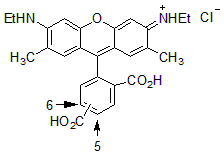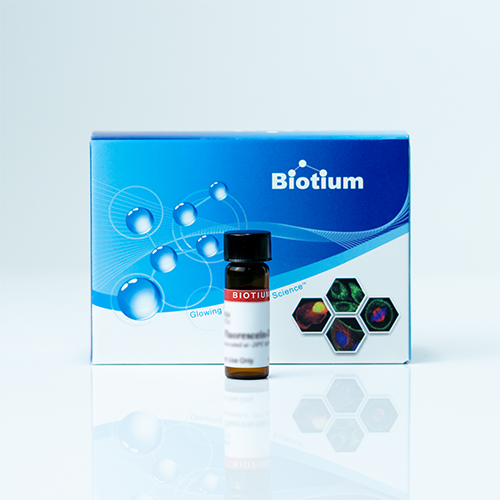5-(and-6)-Carboxyrhodamine 6G, Hydrochloride
The free acid form of orange fluorescent 5-(and-6)-carboxyrhodamine 6G mixed isomers.
This product is available by special order only.
Please fill in the inquiry form and we will contact you shortly.
Please fill in the inquiry form and we will contact you shortly.
Wishlist updated! View wishlist
Product Description
5-(and-6)-Carboxyrhodamine 6G, hydrochloride, is the free acid form of orange fluorescent 5-(and-6)-carboxyrhodamine 6G mixed isomers. Also called 5(6)-CR6G.
- Ex/Em (MeOH) = 520/546 nm
- Orange red solid moderately soluble in DMSO
- Store at -20°C, protect from light
- MW: 494.97

You may also like…
5-Aminoallyl-UTP, Sodium Salt, 10 mM Solution
5-Aminoallyl-UTP can be enzymatically incorporated into RNA for subsequent labeling with an amine-reactive fluorescent dye, biotin, or other hapten.
CF® Dye SE/TFP Ester
CF® Dye SE/TFP esters are amine-reactive fluorescent dyes. They are commonly used to label primary amines of antibodies and other proteins, amine-modified oligonucleotides and other amine-containing molecules.
CFQ520 succinimidyl ester
The amine-reactive quencher, CFQ520 succinimidyl ester, has a broad and intense absorption (approximately 520 nm) but no fluorescence, making it useful as an acceptor in fluorescence resonance energy transfer (FRET) applications.
EDC (EDAC)
EDC (or EDAC) (1-(3-Dimethylaminopropyl-3-ethylcarbodiimide, hydrochloride)) has recently been found to be very useful for fixing in situ chelators, including the fluorescent ion indicators for histological studies following physiological experiments. EDC is also a widely used reagent to activate carboxy groups for amine coupling.
ROX Reference Dye, 25 uM in TE Buffer
A dye used to normalize well-to-well variations that may occur during quantitative, real-time PCR reactions.

